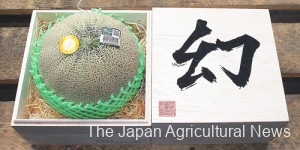IBARAKI, June 12 — A farmers’ market in Hokota, Ibaraki Prefecture, Japan’s top melon producing region, sells rare melons with sugar content of 20 degrees Brix or more, named Maboroshi.
This year, Sungreen Asahi, ran by local agricultural cooperative JA Ibaraki Asahi, started selling melons on April 7. As of the end of May, the number of Maboroshi melons that hit the shelves totaled six, less than 0.001 percent of all the melons sold there, meaning there is very little chance of getting one.
The sugar content of melons is strictly measured at the farm coop’s light sensor fruit sorting facility which started operation in 2004.
The sugar content and maturity of melons are measured one by one, and a quick response (QR) code is attached to each fruit at the time of shipment so that consumers can check the results by scanning it.
Growers’ pursuit of deliciousness and efforts to produce fruits that attract consumers culminated in creation of Maboroshi.
The farmers’ market has been selling melons with sugar content of 18 degrees Brix or more as Kiwami and those with sugar content of 16 degrees Brix or more as Kagayaki.
Even Kiwami melons occupy only 1 percent of the total shipments, which indicates how rare Maboroshi melons are.
Hideki Kawakami, head of Sungreen Asahi, said, “Even staff members at the market don’t know when Maboroshi melons will be available. You are lucky if you can just see it on the shelves.”
Last year, when the farmers’ market started selling Maboroshi melons for the first time, a total of 10 were sold during the season.
The Maboroshi melons, placed in a box made of paulownia wood and sold at 20,000 yen each, proved popular despite the hefty price, with many people buying the fruit as a gift for someone or a treat for themselves.
This reporter visited the store in late May and was lucky enough to see Maboroshi right before it was put on sale. A QR code scan by a smartphone showed that it was an Andes variety melon with sugar content of 20.4 degrees Brix.
Maboroshi can only be found among varieties harvested in spring — Otome, Andes, Quincy and El Sol — and growers say products with sugar content of 20 degrees Brix cannot be seen in the Earls variety melons whose shipments start in July.
“We hope people will visit the farmers’ market to look for the very rare opportunity,” Kawakami said.

A melon ranked as Maboroshi is placed in a paulownia box before hitting the shelves at a farmers’ market in Hokota, Ibaraki Prefecture.

